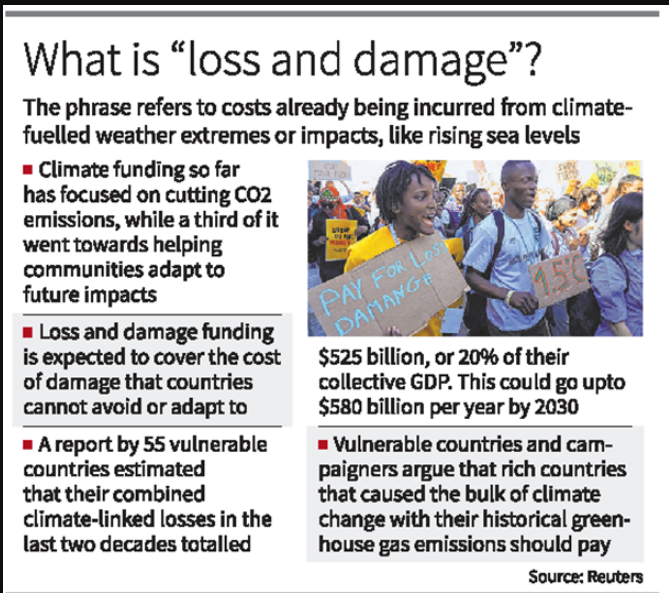Contents
- 1 Introduction
- 2 What is Loss and Damage Fund, and what is the history of genesis of its demand?
- 3 What are the Challenges with operationalisation of the Loss and Damage Fund?
- 4 What are the implications of the impasse over the Loss and Damage Fund?
- 5 What are the advantages of Loss and Damage Fund?
- 6 What Should be the Way forward?
| For 7PM Editorial Archives click HERE → |
Introduction
Loss and Damage Fund is in sharp focus due to the upcoming UNFCCC Conference of Parties (COP 28) to be held in the UAE. After tough negotiations at COP 27 in Egypt in 2022, it was agreed that Loss and Damage Fund (LDF) must be provided to nations vulnerable to or impacted by climate change consequences.
COP28 has overseen the commitment of $475mn to the loss and damage fund. The European
Union has committed around $275million, UAE has pledged $100 million, Germany and the UK pledged $100 million and$75 million respectively. The US will contribute $17.5 million and Japan has committed $10million for the Loss and Damage Fund.
What is Loss and Damage Fund, and what is the history of genesis of its demand?
There are three pillars of dealing with climate change.
| Mitigation | Adaptation | Loss and Damage |
| Mitigation measures refer to the actions which must be taken to limit climate change. For Ex- Cutting greenhouse gas emissions | Adaptation measures refer to the proactive actions taken by countries to cope with the changes induced by climate change. For Ex- Great Green Wall Initiative in the Sahel and West Africa to reduce global warming effect in Africa. | Loss and Damage refers to the irreversible consequences of climate change. It represents the climate change impact that can’t be avoided or mitigated through adaptation efforts. Ex- Floods in Pakistan or risk of submergence of Maldives due to rising sea levels. |
Loss and Damage Fund- The Loss and Damage Fund is to fund the poorer nations (Small Island Nations like Tonga, Fiji) that have made negligible contribution to climate change but are more vulnerable to extreme climate events.
Principle behind the Fund- The fund is based on the “polluters pay principle“. Polluter Pay principle makes the polluter liable for paying the cost of remedial action and compensation for the victims of environmental damage caused by their actions. Thus, the rich and developed nations, which are majorly responsible for industrial emissions, must pay the poorer nations that have made negligible contribution to global warming.

Genesis of the LDF-
The movement of Loss and Damage Fund (LDF) is a three-decade old movement which was first initiated by the island nation of Vanuatu and the Alliance of Small Island States. The progress made at various UNFCCC Conference of Parties (COP) are as follows-
| COP 19, 2013 | At COP 19 in Warsaw, representatives of member countries formally agreed to establish the L&D fund. |
| COP 25, 2019 | Santiago Network for L&D was set up, but the developed countries didn’t commit any funds |
| COP 26, 2021 | Glasgow Dialogue on finance for L&D was established to continue discussions over the next three years on the fund. |
| COP 27, 2022 | At COP 27, the member states agreed to set up the L&D fund and a Transitional Committee (TC) to figure out how the new funding mechanisms under the fund would operate. The TC was also to prepare recommendations that countries would consider, deliberate on, and potentially adopt by COP 28. |
What are the Challenges with operationalisation of the Loss and Damage Fund?
The Transitional committee (TC) formed after COP 27, has been encountering several challenges to get the Loss and Damage Fund operationalised. The key issues are mentioned below-
(1) Hosting of the fund at the World Bank- The World Bank charges an exorbitant overhead fee for maintaining any fund with it. The developing countries want a dedicated funding mechanism and an independent secretariat.
(2) Reluctance of Developed countries to contribute to the fund- The developed nations, particularly the U.S., have remained non-committal about being primary donors to the fund.
(3) Rejection of Common But Differentiated Responsibilities (CBDR) principle- The developed countries have rejected references to the CBDR, equity, and liability in the fund’s draft. This has watered down the spirit and intent of the L&D fund.
Read More– Common But Differentiated Responsibilities
(4) No Commitment over the size of the Fund- There has been no consensus over the size of the fund.
(5) Assessment of Losses- The true assessment of losses is a contentious issue, as it is difficult to ascertain how much of the damage is due to climate change and how much is due to governance failure. Ex- Estimation of loss due to Pakistan flood.
(6) Inclusion of Developing Countries- India also wants the inclusion of Developing countries in the fund (as discussed in the introduction of the article).
(7) Lean Financial Health of the Developed Countries- The US, UK, France are all facing economic slowdown and rise in public debt. For ex- UK’s Debt has increased over 100 % of its GDP.
(8) Lack of devolution formula- No specific devolution formula has been evolved to transfer the Loss and Damage Funds among the Small islands and Developing countries.
What are the implications of the impasse over the Loss and Damage Fund?
(1) Threatens climate justice- The impasse over the fund threatens climate justice and exacerbates the suffering of vulnerable communities in developing nations. These vulnerable communities have contributed minimally to global emissions, but today bear the maximum brunt of climate change.
(2) Increase humanitarian crises- The delay in implementation of the fund will increase humanitarian crises like food shortages, human displacement and conflict.
(3) Worsen the environmental crises- Without adequate L&D funds, there will also be limited capacity to address environmental degradation and the loss of vital ecosystems. This will further worsen environmental crises which are already causing irreversible harm to the earth.
(4) Internal conflicts- Conflicts and tensions emerge in vulnerable nations due to climate change, which can spill across borders. For Ex- Central American Caravan.
(5) Increase of divide between the developed and developing nations- This impasse has created a substantial divide between wealthy and impoverished nations with regard to climate reparations and their historical responsibilities of global warming.
(6) Breakdown of diplomatic efforts- This deadlock shows the failure of the international community to collectively address the contentious issue of climate change and other pressing global issues.
What are the advantages of Loss and Damage Fund?
(1) Holistic coverage of losses due to climate change- Loss and Damage not only includes the economic losses but also the human casualties, and the degradation of ecosystems and cultural heritage. Hence, the fund will comprehensively cover all the losses due to climate change.
(2) Ensures Climate Justice- The fund ensures climate justice to the vulnerable communities of Small Island nations and least developing countries, who have paid the price without even polluting the environment.
(3) Shift of Direction of climate finance- Climate finance has till now focused only on mitigation and adaptation. Two-third of the finance has gone into climate change mitigation and one third has gone into adaptation. The LDF draws the focus of climate finance towards reparations for the loss and damage.
What Should be the Way forward?
1. Sustenance of political commitment for LDF- Sustained political pressure on the issue of LDF will yield fruitful results, similar to the Green Climate Fund.
2. Windfall tax on oil and gas companies’ profits- The windfall tax on oil and gas companies profit’s can be used to fund the Loss and Damage Fund.
3. International insurance pool- In the time being, till the developed countries do not commit to grants, the option of creating an international insurance pool to fund the loss and damage can be explored. The Insurance policies must must insulate stability from climate disaster.
4. Implementation of the “Global Shield Scheme against climate risks”- The German-backed “Global Shield Scheme against climate risks” was also one of the outcomes of COP 27. The Shield is aimed at increasing pre-arranged finance to be disbursed before or just after disasters happen. Till the LDF is not operationalised, this scheme needs to be implemented vigorously.
Conclusion
The L&D fund was conceived as a critical component of global climate action. So to achieve climate justice, rich countries must deliver finance in line with what is fair and just to the Small Islands and Least Developing countries.
| Read More- The Hindu UPSC Syllabus- GS III- Conservation, Environmental Pollution and Degradation, Environmental Impact Assessment |
Discover more from Free UPSC IAS Preparation Syllabus and Materials For Aspirants
Subscribe to get the latest posts sent to your email.







